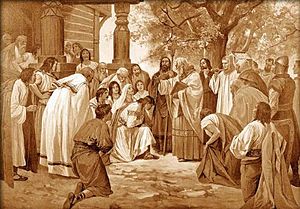
Back المسيحية في العصور الوسطى Arabic Historia del cristianismo durante la Edad Media Spanish مسیحیت در قرون وسطی Persian Kekristenan pada Abad Pertengahan ID Storia del cristianesimo in età medievale Italian 중세 기독교 Korean Istoria de la cristianisme en la eda medieval LFN Христијанството во средниот век Macedonian Kristjaneżmu fil-Medjuevu Maltese Chrześcijaństwo w średniowieczu Polish
This article has multiple issues. Please help improve it or discuss these issues on the talk page. (Learn how and when to remove these messages)
|

Christianity in the Middle Ages covers the history of Christianity from the fall of the Western Roman Empire (c. 476). The end of the period is variously defined - depending on the context, events such as the conquest of Constantinople by the Ottoman Empire in 1453, Christopher Columbus's first voyage to the Americas in 1492, or the Protestant Reformation in 1517 are sometimes used.[1]
In Christianity's ancient Pentarchy, five patriarchies held special eminence: the sees of Rome, Constantinople, Jerusalem, Antioch, and Alexandria. The prestige of most of these sees depended in part on their apostolic founders, or in the case of Byzantium/Constantinople, that it was the new seat of the continuing Eastern Roman, or Byzantine Empire. These bishops considered themselves the successors of those apostles.[2] In addition, all five cities were early centres of Christianity, they lost their importance after the Levant was conquered by the Sunni Caliphate.